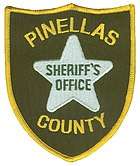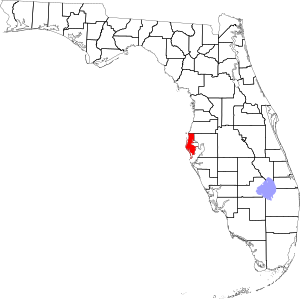Pinellas County Sheriff's Office
The Pinellas County Sheriff's Office (PCSO) is the primary law enforcement agency for Pinellas County, Florida, United States and is responsible for law enforcement services in the unincorporated areas of the county as well as contract cities, jail facilities and courthouse security for Florida's 6th Judicial Circuit.
| Pinellas County Sheriff's Office | |
|---|---|
 | |
| Abbreviation | PCSO |
| Jurisdictional structure | |
| Operations jurisdiction | Pinellas, Florida, USA |
 | |
| Map of Pinellas County Sheriff's Office's jurisdiction. | |
| Size | 608 square miles (1,570 km2) |
| Population | 928,031 |
| General nature | |
| Operational structure | |
| Headquarters | Largo, Florida |
| Agency executive |
|
| Website | |
| Pinellas County Sheriff's Office | |
History
Voters approved the creation of Pinellas County Sheriff's Department in 1912. The early Pinellas County Sheriff's Office reflected the rough and rural nature of the peninsula at that time. Bootlegging, moon shining, and gambling were daily occurrences and the Sheriff's Office was kept busy running after a host of colorful criminals. Jail escapes were common. Newspapers reported how inmates sawed their way through the iron bars with tools smuggled in from the outside.
From the early days until the late 1950s, deputy sheriffs drove their own cars, wore plain clothes and carried their own weapons. The county was divided into several districts, each of which had a Justice of the Peace, to supervise legal matters. There was no centralized jail system. The Sheriff's Office enforced the laws alongside the County Patrol and various municipal police departments. When judges ran short of citizens in a jury pool, deputy sheriffs were sent out to round up citizens to serve. It wasn't until 1959, during the tenure of Sheriff Don Genung, that the sheriff's office took on a modern identity.
Police patrol absorbed
The Sheriff's Office absorbed the County Patrol in 1960. A year later, the Sheriff's Office bought a fleet of 1961 Plymouth Fury automobiles to serve as patrol cars. Sheriff's deputies were issued standardized uniforms. In fact, the shoulder patch worn by deputies now remains unchanged from that time. A standardized training program was developed and Sheriff's Office personnel were given the benefits of civil service, as well as health and retirement plans.
Today
Improvements in technology and law enforcement strategy continued to evolve during the following decades. Presently, the Pinellas County Sheriff's Office consists of over 3,000 Members of Service in five major service categories:
- Patrol Operations
— Uniform Patrol
— Community Policing
— K-9 Unit
— Flight Unit
— Marine & Environmental Lands Units
— SWAT
— DUI Unit
— School Resource Officer Unit
- Investigative Operations
— Property Crimes Division
— Crimes Against Persons Division
— Narcotics Division
- Judicial Operations
— Court Security Division
— Court Processing Division
— Violent Offenders Warrant Unit
— Misdemeanor Probation Division
- Detention and Corrections
— See 'County Jail' section below.
- Support Services
— Communications Division
— Forensics Science Division
— Property/Evidence Section
— Child Protection Investigations Division
- Inspections
— Administrative Investigations Division
— Policy & Accreditation
Sheriff's deputies have countywide jurisdiction, but patrol the unincorporated areas and the cities under contract with the Sheriff's Office for primary law enforcement services.
Contract Cities
|
|
Law enforcement services such as the K-9 Unit, Flight Section, and Marine Unit are available countywide. The Sheriff's Child Protection Investigation Division (CPID), another countywide program, meets the needs of abused and neglected children. The Sheriff's Office also took the lead in tracking sexual predators and offenders by dedicating a team of deputies to monitor the registration and activities of these individuals countywide.
The Youth Services Section has grown to include School Resource Officers in middle schools and high schools, and programs dealing with youthful offenders.
The Sheriff's Office has forged strong community partnerships by offering citizens numerous opportunities to learn more about law enforcement and personal safety. Citizens from around the county can participate in the Sheriff's Citizens Academy, the Sheriff's Advisory Board, Neighborhood Watch, and Volunteers In Partnership (VIPs).
The Pinellas County Sheriff's Office is one of the few law enforcement agencies in the nation to achieve the highest marks in three areas of professional accreditation: law enforcement, corrections and inmate health care.
The agency has pioneered the use of facial recognition technology in law enforcement and corrections and continues to be innovative in the automation of records, forensics science, and the security of property and evidence.
County Jail
Pinellas County Jail (hereinafter PCJ) has a capacity of 4,339 beds. The average daily population is a little over 3,000 people that are either pre-trial or inmates sentenced to a year or less. Inmates sentenced to state prison are picked up by the DOC usually between 1 and 2 weeks after sentencing. Over 500 inmates are sentenced to imprisonment with hard labor to the community and while on the jail compound.
PCJ houses inmates based on factors such as crimes, record, behavior and security. The jail has four facilities: The North, South, Health and Central divisions. The south division is the maximum security unit. It comprises seven pods: Alpha, Delta, Bravo, Echo, Charlie, F-wing, and G-wing. The health division is usually for injured and sick inmates. The central division is a minimum security unit that uses a number system of the floor number plus a pod number. North division holds various types of inmates. C-barracks holds non-sentenced and sentenced men.[1][2]
Visitation is done via a phone and TV monitor. Conjugal visits are not allowed. Visitation must be scheduled based on the inmate's assigned visitation day.
See also
- List of U.S. state and local law enforcement agencies
- Sheriff (Florida)
References
- "Inmate Guide for Pinellas County Jail". Pinellas County Jail inmate guide.
- "Pinellas County Jail information via laws.com". Laws.com.